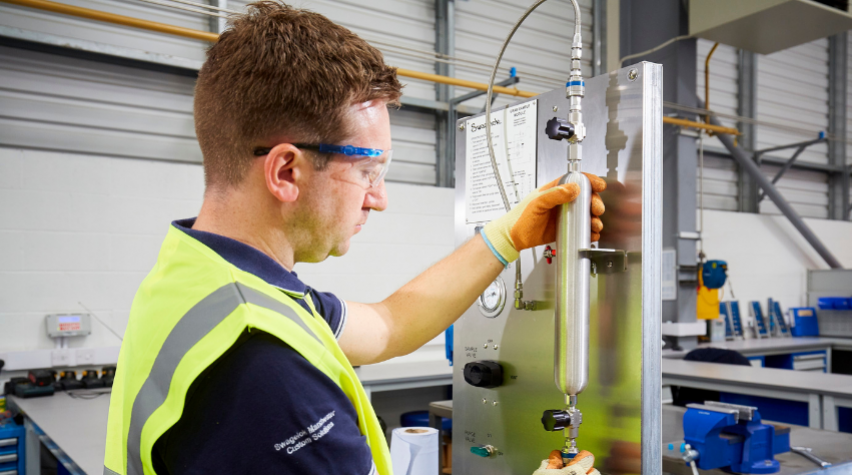
This content is provided by Swagelok and reflects their views, opinions, and insights.
If you are going to successfully optimize your chemical process costs and maintain high-quality product outputs, capturing representative process fluids for laboratory analysis is essential. Grab sampling, also called spot sampling, field sampling, or just sampling, helps validate process conditions and confirms that your product meets internal or customer specifications. Grab sampling can also help verify readings of online analyzers, which many facilities use to obtain real-time insights into their processes.
Gas and volatile liquid grab sampling present specific challenges that operators must overcome to obtain an accurate picture of true process conditions. These challenges can be overcome by following industry-standard best practices.
How to maintain precise process conditions with gas sample cylinders
To avoid changes in composition, gases and volatile liquids must be collected and maintained at temperatures and pressures that prevent phase changes.
There are three simple rules you should follow to obtain accurate grab sampling:
- The sample must represent the process. Use probes to draw samples from the middle of the process pipe and avoid phase changes during sample transportation.
- The sample must be timely. Minimizing transport time from the draw point to the laboratory helps ensure process conditions are accurately represented.
- The sample must be pure. Avoid dead legs upstream of the sample container and allow for adequate purging and flushing of the sampling system to minimize the potential for contamination.
Consider a process fluid that has a gas dissolved into it. If temperatures increase and pressures decrease, the dissolved gas may boil out of the sample. Or consider a gas sample where temperatures decrease and pressure increases, which may cause liquid to condense and drop out of the sample. In each of these scenarios, the sample composition is fundamentally changed and, therefore, is no longer representative of process conditions.
To help prevent these scenarios, you should use sample cylinders instead of the less expensive, unpressurized sample bottles. Using the right container will allow your gas or volatile liquid to maintain the correct phase and preserve sample representativeness. Cylinders will also protect the sample technicians and the environment from potentially toxic fumes or emissions.
How to choose an appropriate cylinder
Most sample cylinders are made with seamless tubing for consistent wall thickness, size, and capacity, but there are some variables to consider based upon your specific sampling needs. You should work with your cylinder supplier to choose the appropriate type for your specific application. When choosing cylinders, you should consider the following features:
- Easily operable quick connects, allowing for efficient and safe connecting and disconnecting from your sampling point
- A smooth internal neck transition, which can help eliminate trapped fluid and makes cylinders easy to clean and reuse
- Proper material composition and finish, as special alloys or materials may be required depending upon the gas or volatile liquid being sampled
- Incorporated bypass lines, which can be beneficial for purging toxic sample remnants and enhancing technician safety. A bypass line allows the purge fluid to flow through the quick connects, ensuring that if spillage occurs when the cylinder is disconnected, the spill is composed of purge fluid rather than the toxic sample.
- Durable design and construction. Sample cylinders must often be transported considerable distances for laboratory analysis.
How to properly fill a cylinder
If sampling a volatile liquid, it is best to fill the cylinder from the bottom to the top. This allows any trapped gas that may be in the cylinder to be flushed out of the top as it is filled, typically through an outage tube. An outage tube also allows the cylinder to maintain some amount of vapor space—a cylinder that is completely filled could potentially rupture in the event of an unexpected change in temperature.
Conversely, when sampling gases, cylinders should be filled from the top down. This allows any condensation that may have formed in the line to be flushed out through the bottom.
How to minimize the potential for human error
Since grab sampling involves technicians, it is possible that human error will be introduced into the process. Sampling systems that reduce the chances of making such mistakes can help make grab sampling safer and more accurate. Using grab sampling panels specifically designed for gas or volatile liquids can help reduce the opportunities for error by eliminating the potential for individual technicians to improperly insert or draw the sample.
Another method to help prevent human error from being introduced into the grab sampling process is to use geared valve assemblies, which ensures all the valves involved in collecting samples are opened in the correct sequence. This eliminates the need for technicians to open and close the valves manually. Geared valve assemblies can also have purge functions incorporated in them, which prevents purge fluids from being reintroduced into the main process through human error.
When there are multiple locations where grab sampling is regularly performed, it is important to eliminate inconsistencies in the process. Selecting a standardized grab sampling panel design for each location can reduce the possibility of confusion and promote consistent processes throughout the facility.
In the end, proper grab sampling techniques should provide you with greater confidence that you are providing the best quality product for your customers. Using simple, well-designed grab sampling systems and following industry-standard best practices at each grab sampling location in your facility will help you achieve those goals.
For a look at how grab sampling can help improve your plant’s safety, register for a webinar presented by Swagelok on November 3, 2021 at 2 p.m. EDT.
Disclosure: This post is sponsored by Swagelok and reflects their views, opinions, and insights.


